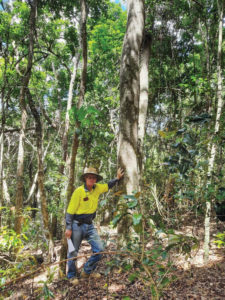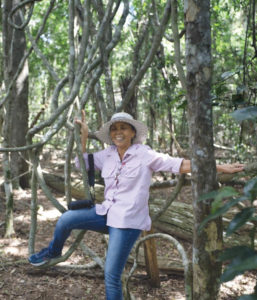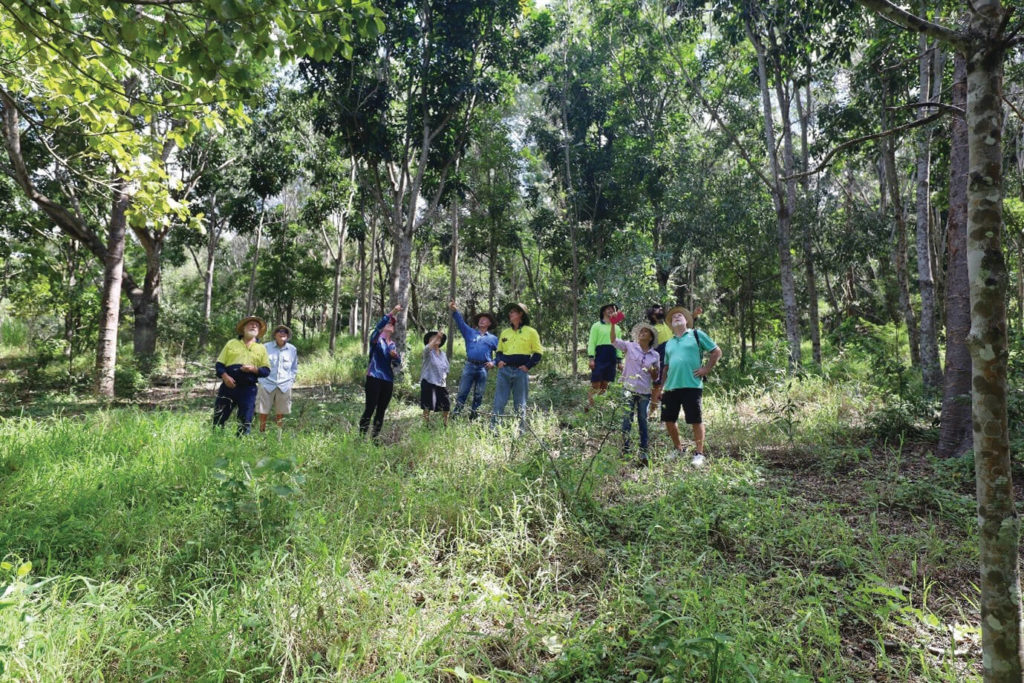
Almost thirty years ago, Craignish landholder Darrell Searle planted a mixed timber plot on his land where his father had previously grown sugar. The plot was on scrub soil, depleted by a generation of cane growing. While planting the plot, Darrell had in mind that he would profit from the mixed specialty cabinet timber species, which included Hoop (Araucaria cunninghamii), Bunya (Araucaria bidwillii) and Kauri (Agathis robusta) Pines. Nowadays, Darrell walks through the plantation, delighting in the soil and microclimate improvement that the planting has facilitated. He no longer considers harvesting these trees because of the extra life they have generated on his property.
The planting is beside remnant dry rainforest, on a steep rocky site that was never cleared. Since he planted, Darrell has noticed that the edge of the remnant rainforest had become lush and green, where it had previously been dying back where it had been buffeted by the prevailing winds.
In March this year, Darrell, who is a Fraser Coast Land for Wildlife member, hosted a “Walk and Talk” for other local members. The “Walk and Talk” entered the timber plot, comparing the growth of the different cabinet timber species. Apart from the Hoop, Bunya and Kauri Pines which dominated the site, other species that grew quite well were White Beech (Gmelina leichhardtii), some of which were fruiting, and the local Marblewood (Acacia bakerii). Masses of rainforest understorey plants were also establishing through bird-drop.

The walk continued into the remnant vine forest where large emergent trees such as Crows Ash (Flindersia australis), Kauri Pine, Marblewood, Lignum-vitae (Vitex lignum-vitae) and Myrtle Ebony (Diospyros pentamera) towered over the mid-storey of twisted lianas and small trees. We then left the sounds of whip birds and the flutter of Caper White butterflies, so characteristic of the rainforest on the slopes, to descend to the open woodlands below. There we discussed fire regimes and contrasted the ecology of the open Grey Box/Blue Gum flats to that of the vine-forested slopes.
Some 15 years ago Darrell was concerned about the loss of stringybarks, such as White Mahogany (Eucalyptus acmenoides) in the district, mainly due to their favoured use for fence posts. So he propagated and planted a plot of stringybarks on an exposed rise. That’s Darrell for you.

Because of the varying ecosystems on Darrell’s property, there were takeaway messages about weeds and property management for each of the participants, but the main delight was the extra life in the soil and arboreal environment that planting trees has given the property.
Jim Johnston
Land for Wildlife Officer
Fraser Coast Regional Council
